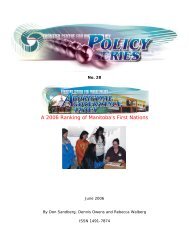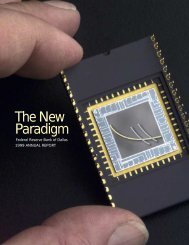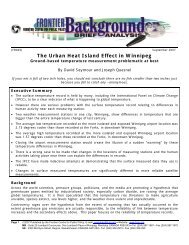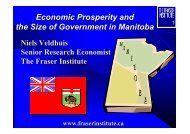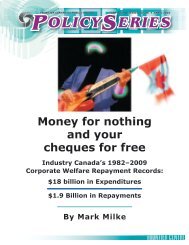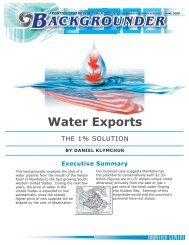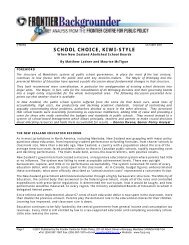The New Paradigm - Federal Reserve Bank of Dallas
Create successful ePaper yourself
Turn your PDF publications into a flip-book with our unique Google optimized e-Paper software.
Notes to<br />
Financial Statements<br />
1. ORGANIZATION<br />
<strong>The</strong> <strong>Federal</strong> <strong>Reserve</strong> <strong>Bank</strong> <strong>of</strong> <strong>Dallas</strong> (“<strong>Bank</strong>”) is part <strong>of</strong> the <strong>Federal</strong> <strong>Reserve</strong> System (“System”)<br />
created by Congress under the <strong>Federal</strong> <strong>Reserve</strong> Act <strong>of</strong> 1913 (“<strong>Federal</strong> <strong>Reserve</strong><br />
Act”), which established the central bank <strong>of</strong> the United States. <strong>The</strong> System consists <strong>of</strong><br />
the Board <strong>of</strong> Governors <strong>of</strong> the <strong>Federal</strong> <strong>Reserve</strong> System (“Board <strong>of</strong> Governors”) and 12<br />
<strong>Federal</strong> <strong>Reserve</strong> <strong>Bank</strong>s (“<strong>Reserve</strong> <strong>Bank</strong>s”). <strong>The</strong> <strong>Reserve</strong> <strong>Bank</strong>s are chartered by the federal<br />
government and possess a unique set <strong>of</strong> governmental, corporate, and central bank<br />
characteristics. Other major elements <strong>of</strong> the System are the <strong>Federal</strong> Open Market Committee<br />
(“FOMC”) and the <strong>Federal</strong> Advisory Council. <strong>The</strong> FOMC is composed <strong>of</strong> members<br />
<strong>of</strong> the Board <strong>of</strong> Governors, the president <strong>of</strong> the <strong>Federal</strong> <strong>Reserve</strong> <strong>Bank</strong> <strong>of</strong> <strong>New</strong> York<br />
(“FRBNY”), and, on a rotating basis, four other <strong>Reserve</strong> <strong>Bank</strong> presidents.<br />
39<br />
Structure<br />
<strong>The</strong> <strong>Bank</strong> and its branches in El Paso, Houston, and San Antonio serve the Eleventh<br />
<strong>Federal</strong> <strong>Reserve</strong> District, which includes Texas and portions <strong>of</strong> Louisiana and <strong>New</strong><br />
Mexico. In accordance with the <strong>Federal</strong> <strong>Reserve</strong> Act, supervision and control <strong>of</strong> the<br />
<strong>Bank</strong> are exercised by a board <strong>of</strong> directors. <strong>Bank</strong>s that are members <strong>of</strong> the System<br />
include all national banks and any state-chartered bank that applies and is approved for<br />
membership in the System.<br />
Board <strong>of</strong> Directors<br />
<strong>The</strong> <strong>Federal</strong> <strong>Reserve</strong> Act specifies the composition <strong>of</strong> the board <strong>of</strong> directors for each <strong>of</strong><br />
the <strong>Reserve</strong> <strong>Bank</strong>s. Each board is composed <strong>of</strong> nine members serving three-year terms:<br />
three directors, including those designated as chairman and deputy chairman, are<br />
appointed by the Board <strong>of</strong> Governors, and six directors are elected by member banks.<br />
Of the six elected by member banks, three represent the public and three represent<br />
member banks. Member banks are divided into three classes according to size. Member<br />
banks in each class elect one director representing member banks and one representing<br />
the public. In any election <strong>of</strong> directors, each member bank receives one vote,<br />
regardless <strong>of</strong> the number <strong>of</strong> shares <strong>of</strong> <strong>Reserve</strong> <strong>Bank</strong> stock it holds.<br />
2. OPERATIONS AND SERVICES<br />
<strong>The</strong> System performs a variety <strong>of</strong> services and operations. Functions include formulating<br />
and conducting monetary policy; participating actively in the payments mechanism,<br />
including large-dollar transfers <strong>of</strong> funds, automated clearinghouse operations,<br />
and check processing; distributing coin and currency; providing fiscal agency functions<br />
for the U.S. Treasury and certain federal agencies; serving as the federal government’s<br />
bank; providing short-term loans to depository institutions; serving the consumer and<br />
the community by providing educational materials and information regarding consumer<br />
laws; supervising bank holding companies and state member banks; and<br />
administering other regulations <strong>of</strong> the Board <strong>of</strong> Governors. <strong>The</strong> Board <strong>of</strong> Governors’<br />
operating costs are funded through assessments on the <strong>Reserve</strong> <strong>Bank</strong>s.<br />
<strong>The</strong> FOMC establishes policy regarding open market operations, oversees these operations,<br />
and issues authorizations and directives to the FRBNY for its execution <strong>of</strong><br />
transactions. Authorized transaction types include direct purchase and sale <strong>of</strong> securities,<br />
matched sale–purchase transactions, purchase <strong>of</strong> securities under agreements to<br />
resell, and lending <strong>of</strong> U.S. government securities. Additionally, the FRBNY is authorized<br />
by the FOMC to hold balances <strong>of</strong>, and to execute spot and forward foreign<br />
exchange and securities contracts in, 14 foreign currencies; maintain reciprocal currency<br />
arrangements (“F/X swaps”) with various central banks; and “warehouse” foreign<br />
currencies for the U.S. Treasury and Exchange Stabilization Fund (“ESF”) through<br />
the <strong>Reserve</strong> <strong>Bank</strong>s.<br />
<strong>Federal</strong> <strong>Reserve</strong> <strong>Bank</strong> <strong>of</strong> <strong>Dallas</strong> 1999 ANNUAL REPORT




